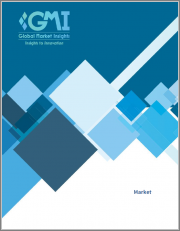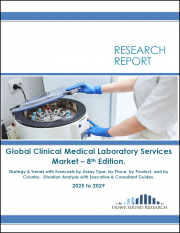
|
시장보고서
상품코드
1399696
멀티오믹스 시장 : 제품·서비스별, 유형별, 플랫폼별, 용도별, 최종 용도별 - 세계 예측(2023-2032년)Multi-omics Market - By Products & Services (Products {Instruments, Consumables}, Services), Type (Single-cell, Bulk), Platform (Genomics), Application (Cell Biology), End-use (Academic & Research Organizations), Global Forecast, 2023-2032 |
||||||
세계의 멀티오믹스 시장 점유율은 세계 정부 투자의 지원에 의해 2023-2032년 15.2%의 CAGR을 기록하하며, 정부기관의 자금 제공 구상은 게놈, 단백질체학, 대사체학 연구를 촉진하며, 의료, 농업, 환경 과학에서 혁신을 추진합니다.
예를 들어 2023년 9월 미국 국립보건원(National Institutes of Health)이 약 1,000만 달러의 초기 자금을 지원하는 '건강과 질병을 위한 멀티오믹스 컨소시엄(Multi-Omics for Health and Disease Consortium)'을 설립했습니다. 100만 달러의 초기 자금 지원으로 이 시장에서 중요한 진전을 이루었습니다. 이 컨소시엄은 인간 건강 탐구를 위한 멀티오믹스 데이터 연구와 분석을 촉진하는 것을 목표로 하고 있습니다. 멀티오믹스는 유전체학, 후성유전체학, 전사체학, 단백체학, 대사체학 등 다양한 '오믹스' 데이터를 통합하는 것입니다. 각 유형은 생물학적 시스템에 대한 고유한 인사이트을 제공하며, 기술 발전과 데이터 과학을 통해 이를 종합적으로 활용하는 것은 종합적인 건강 연구에 엄청난 잠재력을 가지고 있습니다.
이러한 투자는 생물학적 복잡성을 해독하는 첨단 기술을 육성하여 질병 진단, 개인 맞춤형 의료, 작물 개량에 혁명을 가져올 것입니다. 각국 정부가 멀티오믹스의 변혁적 잠재력을 인식하고 있는 가운데, 자금 지원 증가는 시장 수요를 강화하고 다양한 분야의 생물학적 데이터에 대한 이해와 적용을 재구성하는 공동 연구와 선구적인 솔루션을 육성하고 있습니다.
기기 분야는 2023-2032년 큰 발전을 이룰 것으로 보입니다. 유전체학, 전사체학, 단백체학, 대사체학 분석에 특화된 이 툴들은 생명공학 및 의료 분야의 혁신을 촉진할 것입니다. 높은 처리량 기술과 정교한 장비는 종합적인 데이터 수집을 가능하게 하고 복잡한 생물학적 시스템에 대한 인사이트을 촉진합니다. 종합적인 관점을 추구하는 연구 활동이 활발해짐에 따라 복잡한 멀티오믹스 데이터를 분석할 수 있는 첨단 장비에 대한 수요가 증가하고 있습니다. 이러한 수요의 급증은 더욱 정교하고 정밀한 분석 툴의 개발을 촉진하고, 멀티오믹스 연구와 응용의 미래 전망을 형성하고 있습니다.
세포 생물학 분야의 멀티오믹스 시장 규모는 2023-2032년 괄목할 만한 CAGR을 기록할 것으로 보입니다. 유전체학, 전사체학, 단백체학, 대사체학을 통합하는 이 접근법은 복잡한 세포 메커니즘을 밝혀냅니다. 세포의 행동과 기능을 이해하려면 종합적인 데이터 분석이 필요하며, 이는 멀티오믹스 기술의 급격한 증가를 촉진하고 있습니다. 이러한 시너지 효과를 통해 연구자들은 세포의 복잡성을 이해하고 새로운 치료 대상과 질병에 대한 인사이트을 얻을 수 있습니다. 세포 생물학이 복잡한 분자간 상호작용을 더 깊이 파고들면서 멀티오믹스 기법에 대한 시장의 열망이 높아져 생물 의학 연구와 의료 혁신의 획기적인 진전을 이루고 있습니다.
유럽의 멀티오믹스 산업은 2023-2032년 괄목할 만한 CAGR을 기록할 것으로 보입니다. 주요 연구 기관과 자금 지원 구상은 유전체학, 단백질체학, 대사체학 및 그 이상의 분야에서 혁신을 주도하고 있습니다. 종합적인 데이터 분석의 추구는 의료, 농업, 환경 과학의 발전에 대한 유럽의 노력을 반영합니다. 정밀의료와 지속가능한 의료에 중점을 두고 있는 유럽은 멀티오믹스 기술에 대한 의존도가 높아지면서 시장 수요를 촉진하고 있습니다. 이러한 종합적인 오믹스 접근법에 대한 열정은 유럽이 생물 의학 연구와 산업을 변화시키는 응용분야의 미래를 형성하는 데 있으며, 매우 중요한 역할을 하고 있음을 강조합니다.
목차
제1장 조사 방법과 조사 범위
제2장 주요 요약
제3장 멀티오믹스 시장 인사이트
- 업계 상황
- 업계에 대한 영향요인
- 촉진요인
- 오믹스 기술의 진보
- 맞춤형 의료에 대한 응용의 증가
- 정부 구상과 자금 제공의 증가
- 업계의 잠재적 리스크·과제
- 기기와 데이터 스토리지의 고비용
- 복잡한 규제 요건과 표준화 문제
- 촉진요인
- 성장 가능성 분석
- COVID-19 영향 분석
- 규제 상황
- Porter의 산업 분석
- PESTEL 분석
제4장 경쟁 구도
- 서론
- 기업 매트릭스 분석
- 주요 시장 참여 기업의 경쟁 분석
- 경쟁 포지셔닝 매트릭스
- 전략 대시보드
제5장 멀티오믹스 시장 추정·예측 : 제품·서비스별
- 주요 동향 : 제품·서비스별
- 제품
- 기기
- 소모품
- 소프트웨어
- 서비스
제6장 멀티오믹스 시장 추정·예측 : 유형별
- 주요 동향 : 유형별
- 싱글 셀 멀티오믹스
- 벌크 멀티오믹스
제7장 멀티오믹스 시장 추정·예측, 플랫폼별
- 주요 동향 : 플랫폼별
- 유전체학
- 단백질체학
- 대사체학
- 전사체학
- 통합 오믹스 플랫폼
제8장 멀티오믹스 시장 추정·예측 : 용도별
- 주요 동향 : 용도별
- 세포생물학
- 종양학
- 신경학
- 면역학
- 기타 용도
제9장 멀티오믹스 시장 추정·예측 : 최종 용도별
- 주요 동향 : 최종사용자별
- 학술·연구기관
- 제약·바이오테크놀러지 기업
- 병원·진단 연구소
- 기타 최종사용자
제10장 멀티오믹스 시장 추정·예측 : 지역별
- 주요 동향 : 지역별
- 북미
- 미국
- 캐나다
- 유럽
- 독일
- 영국
- 프랑스
- 스페인
- 이탈리아
- 기타 유럽
- 아시아태평양
- 중국
- 일본
- 인도
- 호주
- 기타 아시아태평양
- 라틴아메리카
- 브라질
- 멕시코
- 기타 라틴아메리카
- 중동 및 아프리카
- 남아프리카공화국
- 사우디아라비아
- 기타 중동 및 아프리카
제11장 기업 개요
- Becton, Dickinson and Company
- Thermo Fisher Scientific Inc.
- Illumina, Inc
- Danaher
- PerkinElmer Inc.
- Shimadzu Corporation
- Bruker
- QIAGEN
- Agilent Technologies, Inc.
- BGI
- 10x Genomics
- CYTENA GmbH
Global Multi-omics Market share will witness 15.2% CAGR between 2023 and 2032, propelled by substantial government investments worldwide. Funding initiatives from governmental bodies catalyze research in genomics, proteomics, and metabolomics, driving innovation in healthcare, agriculture, and environmental sciences.
For instance, in September 2023, the establishment of the Multi-Omics for Health and Disease Consortium by the National Institutes of Health marked a significant step in the market, with an initial funding of about $11 million. This consortium aims to propel the study and analysis of multi-omic data for human health exploration. Multi-omics involves amalgamating various 'omics' data types like genomics, epigenomics, transcriptomics, proteomics, and metabolomics. Each type offers unique insights into biological systems, and harnessing these collectively, enabled by technological advancements and data science, holds immense promise for comprehensive health research.
These investments foster advanced technologies that decode biological complexities, revolutionizing disease diagnosis, personalized medicine, and crop improvement. As governments recognize the transformative potential of multi-omics, increased funding solidifies its market demand, fostering collaborations and pioneering solutions that reshape our understanding and application of biological data across diverse sectors.
The overall Multi-omics Market share is classified based on product & services, application, and region.
Instruments segment will undergo significant development from 2023 to 2032. These tools, adept at analyzing genomics, transcriptomics, proteomics, and metabolomics, fuel innovation in biotechnology and healthcare. High-throughput technologies and sophisticated instruments enable comprehensive data collection, driving insights into complex biological systems. As research endeavors increasingly seek holistic perspectives, the market witnesses amplified demand for cutting-edge instruments capable of unraveling intricate multi-omic data. This demand surge propels the development of more refined and precise analytical tools, shaping the future landscape of multi-omics research and applications.
Multi-omics market size from the cell biology segment will register a noteworthy CAGR from 2023 to 2032. Integrating genomics, transcriptomics, proteomics, and metabolomics, this approach uncovers intricate cellular mechanisms. Advancements in understanding cellular behavior and functions necessitate comprehensive data analysis, driving the surge for multi-omics techniques. This synergy allows researchers to dissect cellular complexities, unveiling new therapeutic targets and insights into diseases. As cell biology delves deeper into intricate molecular interactions, the market witnesses a growing appetite for multi-omics methodologies, shaping transformative strides in biomedical research and healthcare innovations.
Europe multi-omics industry will showcase a commendable CAGR from 2023 to 2032. Leading institutions and funding initiatives drive innovation in genomics, proteomics, metabolomics, and beyond. This collective pursuit of comprehensive data analysis reflects Europe's commitment to advancing healthcare, agriculture, and environmental sciences. With an emphasis on precision medicine and sustainable practices, the continent's growing reliance on multi-omics technologies propels market demand. This fervor for integrated omics approaches underscores Europe's pivotal role in shaping the future of biomedical research and transformative applications across industries.
Table of Contents
Chapter 1 Methodology & Scope
- 1.1 Market definition
- 1.2 Base estimates & calculations
- 1.3 Forecast calculation
- 1.4 COVID-19 impact analysis at global level
- 1.5 Data validation
- 1.6 Data sources
- 1.6.1 Primary
- 1.6.2 Secondary
- 1.6.2.1 Paid sources
- 1.6.2.2 Public sources
Chapter 2 Executive Summary
- 2.1 Multi-omics industry 360 degree synopsis, 2018 - 2032 (USD Million)
- 2.1.1 Business trends
- 2.1.2 Regional trends
- 2.1.3 Products & services trends
- 2.1.4 Type trends
- 2.1.5 Platform trends
- 2.1.6 Application trends
- 2.1.7 End-use trends
Chapter 3 Multi-omics Market Insights
- 3.1 Industry landscape, 2018 - 2032 (USD Million)
- 3.2 Industry impact forces
- 3.2.1 Growth drivers
- 3.2.1.1 Advancements in omics technologies
- 3.2.1.2 Increasing applications in personalized medicine
- 3.2.1.3 Rising government initiatives and funding
- 3.2.2 Industry pitfalls & challenges
- 3.2.2.1 High cost of instruments and data storage
- 3.2.2.2 Complex regulatory requirements and standardization issues
- 3.2.1 Growth drivers
- 3.3 Growth potential analysis
- 3.3.1 By products & services
- 3.3.2 By type
- 3.3.3 By platform
- 3.3.4 By application
- 3.3.5 By end-use
- 3.4 COVID-19 impact analysis
- 3.5 Regulatory landscape
- 3.6 Porter's analysis
- 3.7 PESTEL analysis
Chapter 4 Competitive Landscape, 2022
- 4.1 Introduction
- 4.2 Company matrix analysis, 2022
- 4.3 Competitive analysis of major market players, 2022
- 4.4 Competitive positioning matrix, 2022
- 4.5 Strategic dashboard, 2022
Chapter 5 Multi-omics Market Estimates and Forecast, By Products & Services, 2018-2032 (USD Million)
- 5.1 Key trends, by products & services
- 5.2 Products
- 5.2.1 Instruments
- 5.2.2 Consumables
- 5.2.3 Software
- 5.3 Services
Chapter 6 Multi-omics Market Estimates and Forecast, By Type, 2018-2032 (USD Million)
- 6.1 Key trends, by type
- 6.2 Single-cell multi-omics
- 6.3 Bulk multi-omics
Chapter 7 Multi-omics Market Estimates and Forecast, By Platform, 2018-2032 (USD Million)
- 7.1 Key trends, by platform
- 7.2 Genomics
- 7.3 Proteomics
- 7.4 Metabolomics
- 7.5 Transcriptomics
- 7.6 Integrated omics platforms
Chapter 8 Multi-omics Market Estimates and Forecast, By Application, 2018-2032 (USD Million)
- 8.1 Key trends, by application
- 8.2 Cell biology
- 8.3 Oncology
- 8.4 Neurology
- 8.5 Immunology
- 8.6 Other applications
Chapter 9 Multi-omics Market Estimates and Forecast, By End-use, 2018-2032 (USD Million)
- 9.1 Key trends, by end-use
- 9.2 Academic and research organizations
- 9.3 Pharmaceutical & biotechnology companies
- 9.4 Hospital and diagnostic laboratories
- 9.5 Other end-users
Chapter 10 Multi-omics Market Estimates and Forecast, By Region, 2018 - 2032 (USD Million)
- 10.1 Key trends, by region
- 10.2 North America
- 10.2.1 U.S.
- 10.2.2 Canada
- 10.3 Europe
- 10.3.1 Germany
- 10.3.2 UK
- 10.3.3 France
- 10.3.4 Spain
- 10.3.5 Italy
- 10.3.6 Rest of Europe
- 10.4 Asia Pacific
- 10.4.1 China
- 10.4.2 Japan
- 10.4.3 India
- 10.4.4 Australia
- 10.4.5 Rest of Asia Pacific
- 10.5 Latin America
- 10.5.1 Brazil
- 10.5.2 Mexico
- 10.5.3 Rest of Latin America
- 10.6 Middle East & Africa
- 10.6.1 South Africa
- 10.6.2 Saudi Arabia
- 10.6.3 Rest of Middle East & Africa
Chapter 11 Company Profiles
- 11.1 Becton, Dickinson and Company
- 11.2 Thermo Fisher Scientific Inc.
- 11.3 Illumina, Inc
- 11.4 Danaher
- 11.5 PerkinElmer Inc.
- 11.6 Shimadzu Corporation
- 11.7 Bruker
- 11.8 QIAGEN
- 11.9 Agilent Technologies, Inc.
- 11.10 BGI
- 11.11 10x Genomics
- 11.12 CYTENA GmbH



















